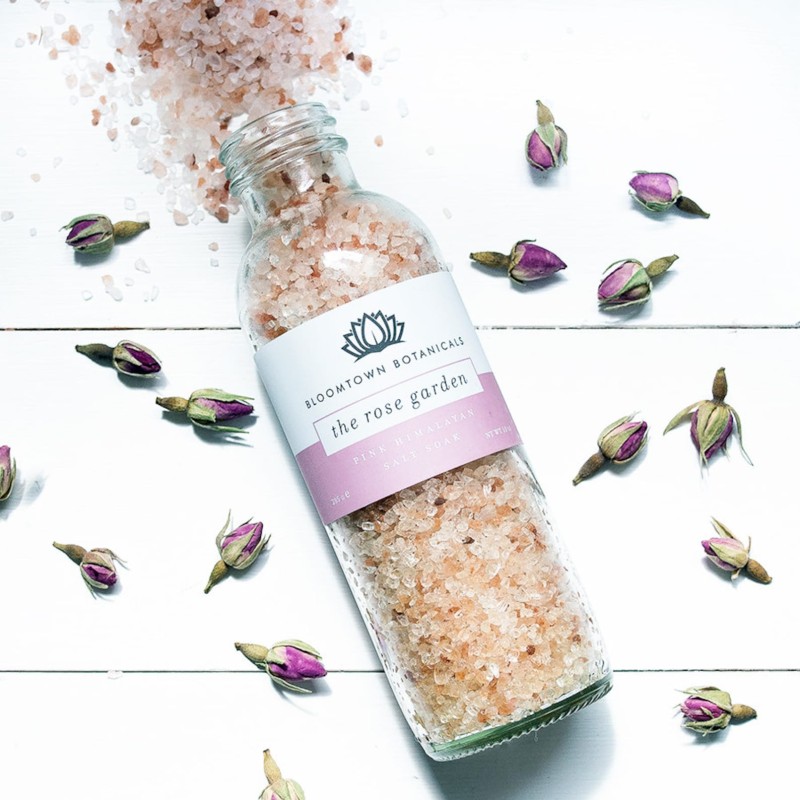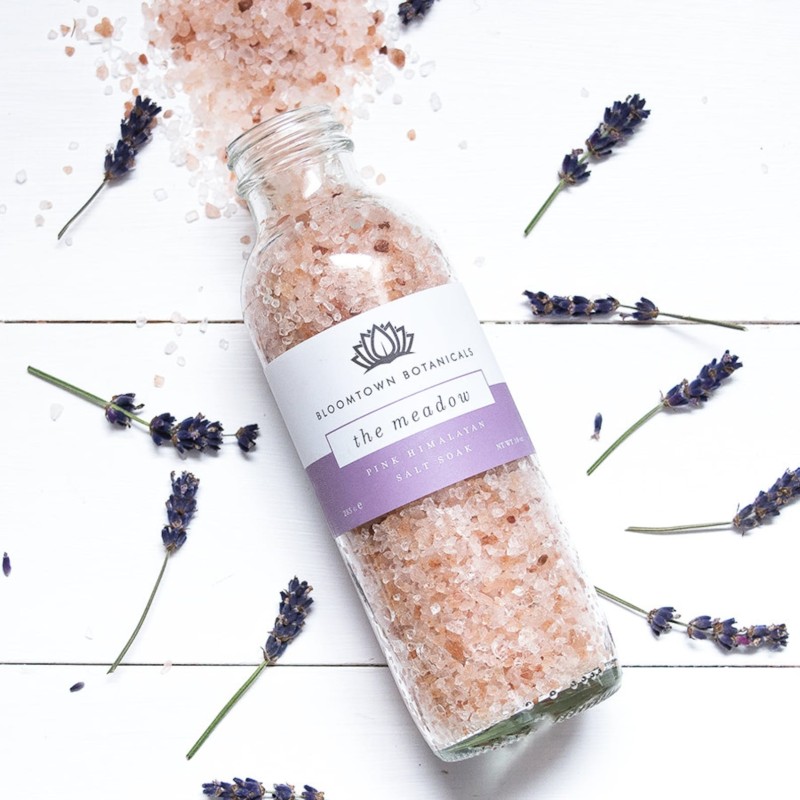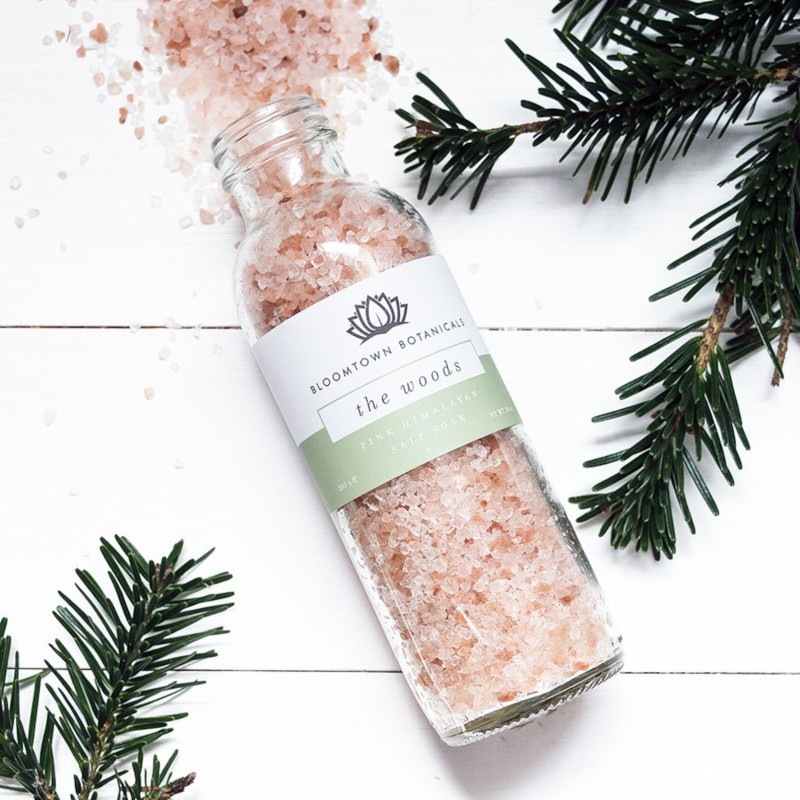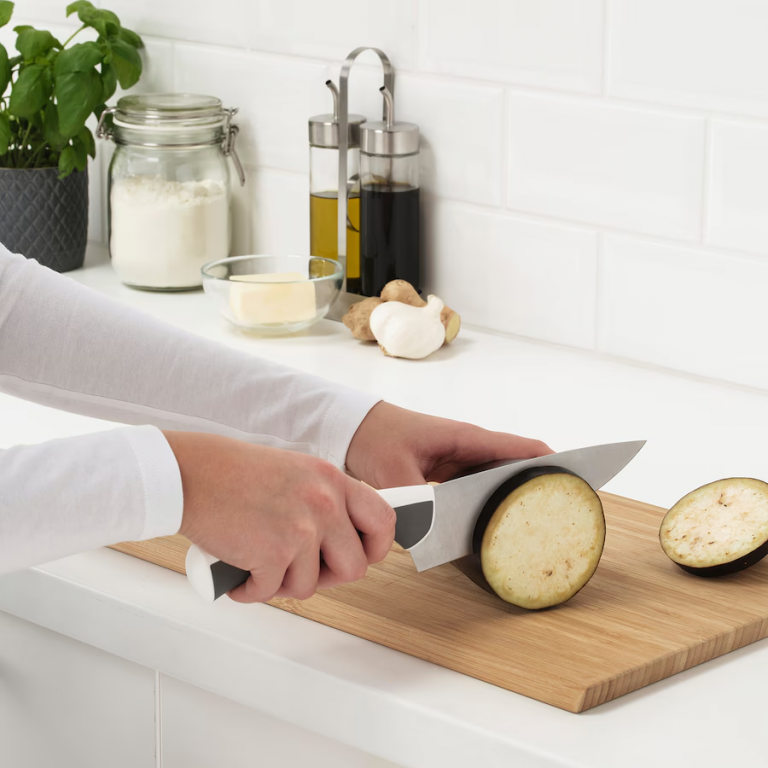
Bloomtown Bath Salts are something special. Made with Himalayan salts (not Dead Sea Salts, which are not recommended by environmentalists), these are scented in various floral ‘flavours’ and sold in zero waste glass jars.
They cost around £10, but each jar gives enough for around 5 baths. So if you treat yourself to a weekly soak, this only works out at around £2 a bath. Salt baths can draw out excess moisture and swelling from aching joints.
Do not use bath salts on broken skin. Ask your doctor before use, if you have including diabetes, kidney disease, eating disorders or low-magnesium diets. Stop if you notice skin irritation, itching, or dizziness, and speak with a professional.

Choose from:
- Rose Garden (lush modern rose with not-too-sweet white florals)
- Hedgerow (Cornish-inspired blackberry & sweet honeysuckle)
- Meadow (the classic – lavender, chamomile & rose geranium)
- The Woods (grounding cedar & bergamot – ideal for men)
- The Grove (blood orange & grapefruit)

You Don’t Need Aromatherapy Oils
Aromatherapy oils can clog drains and harm marine wildlife if poured neat down drains (as well as causing slips in the bath).
Just hot water and peaceful relaxation. If you use essential oils, just add a few drops to a full warm water bath, so they dilute enough to biodegrade.
Avoid aromatherapy oils (and hibiscus) for pregnancy/nursing or affected medical conditions (asthma, epilepsy, high blood pressure).
The Benefits of Himalayan Bath Salts
These pink salts come from ancient deposits in Pakistan’s Punjab region. The soft rose hue comes from trace minerals such as iron. Alongside sodium chloride, they contain over 80 trace minerals, including magnesium, potassium, and calcium, which many people use to support the skin and body during a warm soak.
Ease Muscle Tension and Joint Pain
A warm bath already eases tight muscles, but salts can lift the experience. The magnesium in Himalayan salts is linked with muscle relaxation, as it supports electrolyte balance and helps calm the nervous system. When dissolved in warm water, salts create a soothing solution that can help the body release tension.
For best results, fill the tub with warm water at around 37 to 39°C. Sprinkle in the salts and stir until fully dissolved. Soak for 20 to 30 minutes, letting the water cover tight areas like calves, lower back, and shoulders. This window gives time for heat, buoyancy, and minerals to work together.
Many people use Epsom salts for similar goals. Epsom salts are magnesium sulphate, and small studies and long tradition support their use for post-exercise soreness. Himalayan salts share some of these effects, and also bring extra trace minerals to the bath. That broader mineral profile is part of their appeal.
If your muscles feel tight after a run, a gym session, or long hours at a desk, a salt bath can help release knots and improve comfort. Pair your soak with gentle stretches. For example, ankle circles and light hamstring stretches in the water can help flush tired legs. Move slowly, breathe deeply, and stop if anything feels sharp.
- How much salt: Add 1 to 2 cups to a standard tub. Larger baths may need a bit more.
- When to soak: Try it after exercise or in the evening, when your body is ready to unwind.
- Hydrate: Drink water before and after to replace fluids.
How Minerals Aid Recovery After Workouts
Magnesium supports muscle relaxation, while calcium helps with normal muscle function. Sulphate (present in many mineral salts) is involved in natural detox pathways, and some users find it helps reduce that heavy, post-leg-day feeling. Warm water boosts blood flow, which can carry fresh oxygen and nutrients to tired tissue.
A simple example makes this clear. After a hill run, Tom added two cups of Himalayan salts to a warm bath and soaked for 25 minutes. He stretched lightly in the water, drank a glass of water after, and reported far less morning stiffness than usual. Short, steady steps like these can make recovery feel easier.
Relief for Everyday Aches and Pains
You do not have to be an athlete to enjoy relief. Many people use salt baths for back ache, tight necks from screens, or mild arthritis symptoms. Regular use may help reduce inflammation and improve day-to-day comfort. Try two or three baths a week and track how you feel over a month.
Nourish and Detoxify Your Skin
Himalayan bath salts are a gentle, mineral-rich way to pamper your skin. The fine crystals act as a mild exfoliant, helping to remove dead skin cells that make skin look dull. Once dissolved, the minerals support hydration and leave skin feeling soft to the touch.
Many users talk about detox benefits. Through a process similar to osmosis, a salt solution can help draw out surface impurities and reduce build-up in pores. The warm water opens pores, the salts cleanse, and you step out feeling fresher. Some trace elements also have antibacterial properties, which helps keep skin clear.
Himalayan salts differ from regular sea salt. They are mined from ancient deposits, which gives them a unique purity and a broad spread of trace minerals. The pink colour hints at iron, but potassium, magnesium, and calcium also play a role in the skin’s look and feel.
Try this basic bath recipe:
- Add 1.5 to 2 cups of Himalayan bath salts to warm water.
- Soak for 20 minutes, then pat skin dry. Avoid rinsing off the minerals completely.
Looking for visible results? Expect smoother skin, less roughness on elbows and heels, and a clean, comfortable feel that lasts into the next day.
Deep Cleanse for a Healthier Complexion
A weekly salt soak can help keep pores clear and reduce the look of acne on the back, shoulders, or chest. The combination of warm water and minerals supports a healthier skin barrier. Many people notice that skin feels clean, not stripped, which is key for balance.
Think of that clear-headed, fresh-faced feeling after a seaside swim, but at home. Pores feel less clogged, skin looks brighter, and texture improves with steady use.
Moisturise Naturally Without Lotions
Salts help balance skin pH and support moisture retention. After a soak, skin often feels supple even without heavy creams. This is helpful for dry or eczema-prone skin, where less friction and more hydration can calm flare-ups.
That said, always patch test. Try a small amount on the inner arm before a full bath if your skin is sensitive. Keep water warm, not hot, and finish by patting dry, then sealing in moisture with a light, fragrance-free lotion if needed.
Promote Relaxation and Better Sleep
The right bath can reset your evening. Himalayan bath salts support the body’s natural relaxation response. Warm water helps lower cortisol levels over time, and magnesium is known for a calming effect on the nervous system. Together, they create the ideal setting for rest.
Make your bath a ritual. Use it an hour before bed, keep the lights low, and play soft music. A tidy bathroom, a favourite candle, and a clean towel can turn a normal night into something restorative. Small touches matter.
Aim for 20 to 30 minutes. Step out, cool down for a few minutes, then get into bed. Avoid screens and heavy meals late in the evening. You will likely notice deeper, more consistent sleep when you keep to the habit two or three times a week.
Reduce Daily Stress and Anxiety
Stress piles up, and it shows in the body. A salt bath helps you slow down and reconnect with your senses. Warm water relaxes tight muscles, while a subtle scent from a drop of essential oil engages the mind.
Try this short practice:
- Inhale for 4 counts, pause for 2, exhale for 6.
- Repeat for five minutes in the bath.
Busy parents, shift workers, students, and carers can all benefit from this pocket of calm. Even a quick 15-minute soak can steady a restless mind.
Enhance Sleep Patterns Naturally
With regular evening soaks, many people fall asleep faster and wake feeling more refreshed. Consistency is key. Try two to three baths a week, and pair the routine with a cool, dark bedroom and a steady bedtime.
Track your sleep for a fortnight. Do you wake less often? Do mornings feel easier? Small changes add up when you keep the habit simple.






